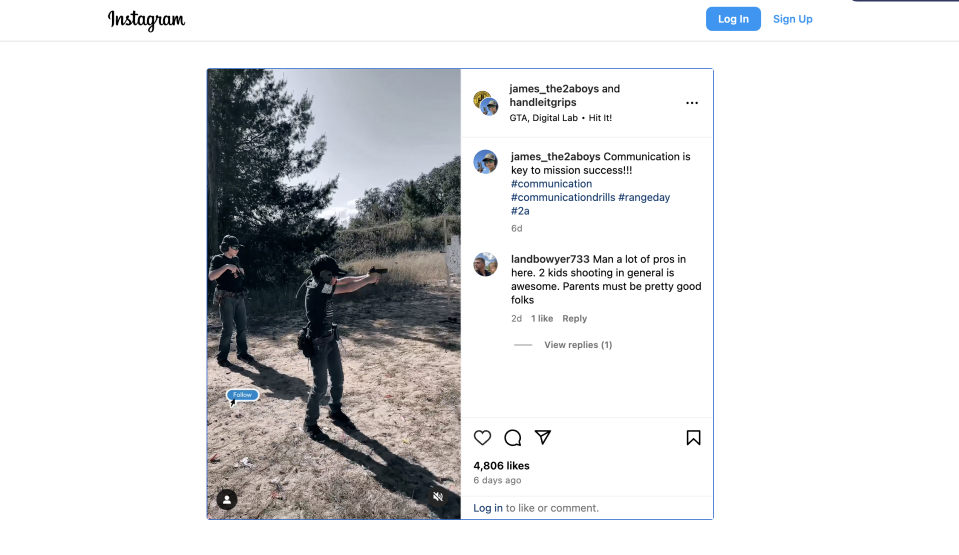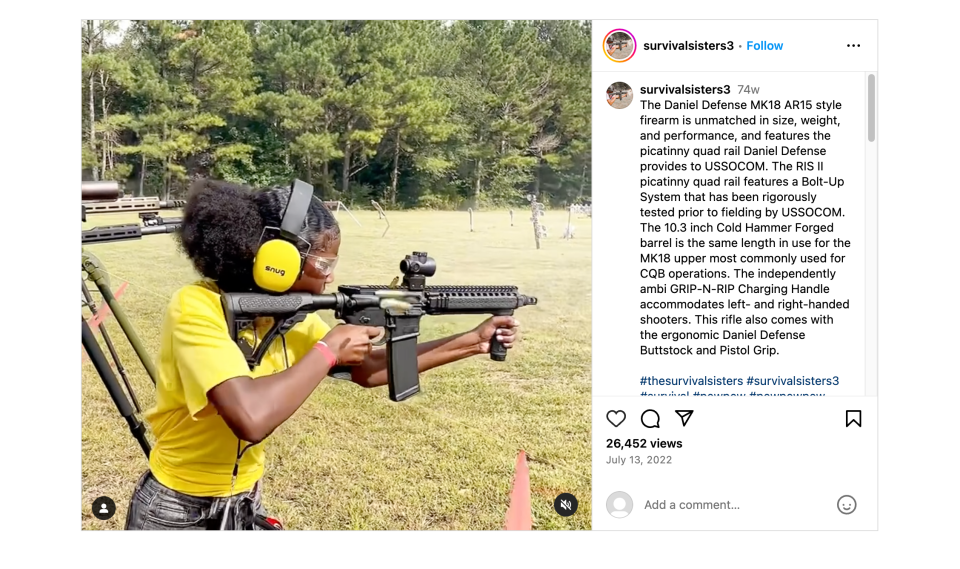Just a hobby or reckless marketing gimmick? The world of kid gun influencers.
Grant Davis has the perfect AR-15 for you. It has a muzzle brake for straighter shooting, an extended magazine release for faster reloads and a tactical handguard. He shows it off on Instagram reels, strutting around the Florida shooting range, squeezing off rounds synced to music.
Grant is about to turn 10. He’s part of the burgeoning group of kid gun influencers, “kidfluencers,” nationwide and one half of the “2A Boys” – with his 14-year-old brother James.

They’re relative newcomers on the scene, but they’re competing as breakout stars this year in a gun influencer social media contest known as The Gundies. Winners take home a $3,000 prize pack from Palmetto State Armory with a new AR rifle and 9mm pistol.
The niche marketers with their de facto poster child Autumn Fry, an 11-year-old gunslinger with 240,000 YouTube subscribers, have drawn scrutiny from gun control groups, state governments and, recently, the White House and its new Office of Gun Violence Prevention.
“Marketing guns to children is abhorrent, including the shameful practice of gun manufacturers using social media to encourage children to purchase deadly weapons,” White House spokesman Jeremy M. Edwards told USA TODAY. “This is especially alarming when we know that guns are the No. 1 killer of kids.”
Most states have age minimums to buy or possess firearms – either 18 or 21 – but almost all offer exceptions for hunting and shooting with parental supervision.
President Joe Biden signed an executive order in March encouraging the independent Federal Trade Commission to study gun marketing tactics aimed at minors. The agency has not done so and when pressed about progress, FTC spokesman Douglas Farrar declined to comment.
Gun marketing to kids has a long history, dating back to National Rifle Association ads in magazines in 1907 calling on boys to become a “Junior Marksman” or organize NRA rifle clubs in their schools to “instill the principle of manhood and loyal citizenship in the youth of the land.”
Investigation: Are gun advertisements in FTC’s crosshairs? Critics decry ‘toxic’ messaging as firearm sales soar
The gun violence prevention group Sandy Hook Promise issued a report this fall detailing how firearm manufacturers are targeting a new generation of buyers and enthusiasts. Among the trends they called problematic is the proliferation of influencers too young to have their own social media pages, let alone purchase or possess firearms.
“Because kids are the best messengers to other kids, the success of these channels underscores the fact that the companies paying them clearly know that they are marketing to children,” the group wrote.
The report called out the accounts Tactical Mia, Autumn Fry, Cheyenne Dalton and the Survival Sisters as influential preteen, tweens and teens in the space.
Representatives for Tactical Mia, 9, and Autumn Fry, 11, declined to comment for this article. Both responded with warnings not to publish their “images, content, videos, names, likeness or logo.” Operators of other popular accounts said their posts are purely entertainment and not aimed at financial gain.
A single brand mention on Autumn’s YouTube page, however, could bring in $400 to $3,000, according to estimates by the marketing analyst company HypeAuditor. Her top video has 3.3 million views of her small hands manipulating a desert tan 9mm Sig Sauer M18 pistol. She also sells autographed shell casings for $10 or you can use discount code AUTUMN for youth-sized body armor at Premier Body Armor.
Mia’s competition shooting videos, ammo and shooting jersey with her name are sponsored by Laser and PnR ammunition. Others are listed as sponsors for her hearing protection, targets, optics, eye protection and holsters. Named financial backers also include the National Rifle Association.
Gun advertising became a flashpoint in the aftermath of the Sandy Hook shooting and the $73 million legal settlement by Remington over its advertisements aimed at troubled men. Then after the Robb Elementary shooting last year, Congress called the CEOs of top gun manufacturers to testify at a panel. Among them was Daniel Defense’s Marty Daniel, who said the company deleted an ad featuring a child after the Uvalde shooting.
“We took this ad down, although it had a good message,” Daniel said at the July 2022 hearing.
A way of life
For Fred Thrasher, posting on the Survival Sisters accounts offers a window into the family’s way of life.
He hosts his four daughters, Charli, 14; Naomi, 15; Kennedy, 16; and Brooke, 18, on the channel that features shooting, but also “ditch medicine,” emergency bleeding control, survivalist camps and drills on how to react to a mall shooting.

“We don’t cater to children; our target demographic is moms and dads 35-65,” Thrasher told USA TODAY, adding that no companies pay to sponsor the channel and that the survival camps they host aren’t very lucrative. The two-night camping, close quarter combat, gun and knife training events cost $199, or $500 for a family of four.
“No one wants to market guns to children; they’re not influencers, they’re just living their life,” Thrasher said. “This is our time together instead of screen time. We promote family and skills and critical thinking, but they’re not obsessed with guns.”
Thrasher noted that unlike rap videos, none of his content promotes crime or glamorized firearms. He says it’s an added challenge to be a family of Black shooters, and women, in an industry dominated by white men.
He’s also acutely aware of the politics surrounding both firearms and children influencers. He says he’s advocating for responsible gun ownership. His four daughters declined to be interviewed.
Keith Davis, the father of 2A Boys Grant and James, echoed that perspective. He says he shot competitively in high school and is showcasing a family hobby. The boys declined to comment themselves through Davis.
“If you watch my kids’ content, they’re obviously very well trained, they’re not doing anything unsafe,” Davis said. “I think of what they’re doing as a modern martial art. You take your kid to karate class, what is that teaching them? Self-defense, discipline and a strong work ethic are three very important life skills for a man to have.”
Davis says they don’t have paid partnerships with or accept in-kind gifts from any brands but would consider them to offset their growing ammunition bill. Some of his kids’ posts feature them as unpaid “ambassadors'' for gear like Garaysar shotguns and Hyperion Munitions that provide free samples and loaner guns at range events. The brands then repost content of the boys shooting their products.
Davis and his wife hold the keys to the social media accounts in part to shield the boys from negative feedback online. He also says their firearms are safely stored while not at the range.
“They’re aware of the politics involved and the way we live our lives,” he said. “We believe in freedom and the naysayers have a right to say what they want.”
Criticism and possible changes
Rachael Albers calls herself a “marketing muckraker.” She took an interest in gun influencers while researching an upcoming book on all kinds of kidfluencers, momfluencers and family vloggers.
Her biggest concern about the young gun influencers: Kids have a hard time discerning advertising content from entertainment.
“Studies have shown that until you’re 8, you pay the same attention to the ad as the show you’re watching,” Albers said. “And children tend to pay more attention and trust information coming from a peer.”
Albers said some of the kidfluencers may not have paid brand contracts now, but are basically unpaid interns laying groundwork for future paying gigs. She blamed the NRA and manufacturers for cultivating a gun culture aimed at a younger and younger audience.
She thinks restrictions on this type of gun marketing should be the least controversial of gun control reforms.
“I have a bias, but I think most people can agree we shouldn’t be marketing guns to kids,” she said. “I’ll relent on your rights argument, you have a right to take your kid to a range, but we don’t market alcohol or cigarettes to kids anymore.”
Albers cited a variety of options: States could enact stricter marketing rules, social media companies could crack down and the FTC could put better rules in place – and enforce them.
California enacted regulations on gun marketing to kids, recently blocked by a U.S. appeals court, and Illinois recently passed a law that requires parents to put kidfluencer revenue into a trust until the child turns 18.
Meta policy dictates anyone under 13 years old is prohibited from using Instagram and Facebook and the company uses age screens, a user-reporting system and a team of content reviewers to flag reported accounts that appear to be used by underage people.
The company has cracked down on the sale or use of weapons, ammunition or explosives on the platforms, but groups, individuals and companies routinely find creative tactics to avoid detection and evade enforcement.
Social media companies including YouTube must adhere to the Children’s Online Privacy Protection Act and specify whether content is “made for kids.” In 2019, the FTC fined its parent Google $170 million for violating that law.
YouTube channels for Autumn Fry and Tactical Mia's pages are not designated as "made for kids" under FTC's rules and would not appear in YouTube Kids, said YouTube spokesperson Ivy Choi. Content that doesn't violate the site's community guidelines can still be flagged as inappropriate for viewers under 18, only accessible by those confirmed to be 18 or older. But Choi said neither Autumn nor Mia's content met the bar for age restriction.
Some young creators use their platforms to complain about censorship and “shadow banning.” Autumn Fry switched some of her posts from YouTube to the block-chain-based service Odysee. While that system has much looser restrictions, critics have also called it a safe haven for Neo-Nazis and white supremacy.
Representatives from Forge Relations, the North Carolina marketing firm that hosts The Gundies, did not return messages seeking comment on the kid influencers. Neither did popular gun sellers Palmetto State Armory or Brownells, which sponsor the awards.
A ceremony is scheduled in Las Vegas inside the Venetian on Jan. 22 to announce the winners – a day before the kickoff of the SHOT Show, the gun industry’s largest gathering.
Gun Owners of America, which bills itself as the “no compromise” gun lobby, sponsors the female influencer category at the awards, including nominees Tactical Mia and Autumn Fry. Senior Vice President Erich Pratt defended marketing to minors and said the holidays are a perfect time to purchase a child their first gun.
“To say that we can’t promote a constitutional right to minors, including the right to bear arms, is nonsense,” he said. “Imagine the outrage if some group started trying to persuade minors that voting was 'dangerous' or 'not productive.’
“At the end of the day, those on the other side of this debate are waging this fight to demonize firearms, because they illogically believe that guns are the cause of violence, which is false.”
Nick Penzenstadler is a reporter on the USA TODAY investigations team. Contact him at npenz@usatoday.com or @npenzenstadler, or on Signal at (720) 507-5273.
This article originally appeared on USA TODAY: A 9-year-old AR-15 salesman? New gun influencers are shockingly young

